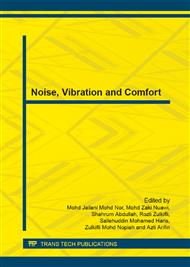p.59
p.64
p.69
p.74
p.81
p.89
p.97
p.102
p.107
Influence of Silica Sand Particles on Disc Brake Squeal Noise
Abstract:
Researchers in recent years begin to explore on tribological behavior of automotive brake squeal phenomena which covers the morphology, chemical composition, friction and wear, phase composition and third body or friction film distribution. However less effort has been made to study the tribological on the influence of small particles on brake squeal. During braking condition, both rotor and pads are exposed to road environmental particle which may affect pads surface condition. In order to assess the influence of this particle on brake squeal a series of squeal tests were performed. Silica sand grit particles with a size range between 400 to 200 μm which most available on the road surface were used in this experiment. Brake pad and disc surface characteristics were analyzed before and after squealing condition using Scanning Electron Microscope (SEM) and Energy dispersive X-ray analysis (EDX). The result shows that the silica sand particles had influence the squeal and surface behavior of the brake pad.
Info:
Periodical:
Pages:
81-85
Citation:
Online since:
December 2013
Keywords:
Price:
Сopyright:
© 2014 Trans Tech Publications Ltd. All Rights Reserved
Share:
Citation:


